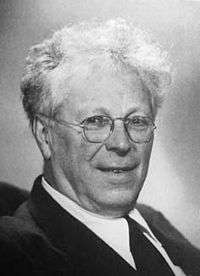Abram Samoilovitch Besicovitch
| A. S. Besicovitch | |
|---|---|
|
Abram Samoilovitch Besicovitch (1891–1970) | |
| Born |
Abram Samoilovitch Besicovitch 23 January 1891 Berdyansk, Russian Empire |
| Died |
2 November 1970 (aged 79) Cambridge, UK |
| Residence | United Kingdom |
| Nationality | Russian Empire and British |
| Fields | Mathematician |
| Institutions |
University of Liverpool University of Cambridge |
| Alma mater | St Petersburg University |
| Doctoral advisor | Andrey Markov[1] |
| Doctoral students |
Oliver Aberth Roy Davies Joseph Gillis Patrick Moran Ernst Reifenberg Samuel Taylor Gholamhossein Mosaheb Grant Walker[1] |
| Known for |
Hausdorff-Besicovitch dimension Besicovitch functions Besicovitch covering theorem |
| Influenced | Freeman Dyson[2] |
| Notable awards |
Adams Prize (1930) De Morgan Medal (1950) Sylvester Medal (1952) Fellow of the Royal Society[3] |
Abram Samoilovitch Besicovitch (or Besikovitch)[3] (Russian: Абра́м Само́йлович Безико́вич; 23 January 1891 – 2 November 1970) was a Russian mathematician, who worked mainly in England. He was born in Berdyansk on the Sea of Azov (now in Ukraine) to a Karaite family.[4][5][6][7][8][9][10]
Life and career
Abram Besicovitch studied under the supervision of Andrey Markov at the St. Petersburg University, graduating with a PhD in 1912.[1] He then began research in probability theory. He converted to Eastern Orthodoxy, joining the Russian Orthodox Church, on marrying in 1916. He was appointed professor at the University of Perm in 1917, and was caught up in the Russian Civil War over the next two years. In 1920 he took a position at the Petrograd University.
In 1924 he went to Copenhagen and Harald Bohr, on a Rockefeller Fellowship, where he worked on almost periodic functions, which now bear his name. After a visit to G.H. Hardy at the University of Oxford, he had appointments at the University of Liverpool in 1926, and the University of Cambridge in 1927.
After moving to Cambridge in 1927, and by 1950 he had been appointed to the Rouse Ball Chair of Mathematics, which he held until his retirement in 1958, he then toured the USA for eight years before returning to Trinity College Cambridge until probably his death in 1970. He was appointed Lecturer in the Faculty of Mathematics, and therefore received recognition as a Cambridge MA by 'Special Grace' on 24 November 1928. He worked mainly on combinatorial methods and questions in real analysis, such as the Kakeya needle problem and the Hausdorff-Besicovitch dimension. These two particular areas have proved increasingly important as the years have gone by.
He was also a major influence on the economist Piero Sraffa, after 1940, when they were both Fellows of Trinity College, Cambridge, and on Dennis Lindley, one of the founders of the Bayesian movement in the United Kingdom. He was J.E. Littlewood's successor in 1950 in the Rouse Ball chair at the University of Cambridge, retiring in 1958. He died in Cambridge.
Awards and honours
Besicovitch was in 1934 made FRS[3] and in 1952 won the Sylvester Medal from the Royal Society.[11] He received in 1950 the De Morgan Medal of the London Mathematical Society. He was a visiting scholar at the Institute for Advanced Study in the fall of 1954.[12]
Besicovtich's candidacy for the Royal Society reads:
"Distinguished as a pure mathematician, particularly for his researches in the theory of functions of a real variable, the theory of analytic functions, and the theory of almost periodic functions. "[13]
The asteroid 16953 Besicovitch is named in his honour.
A portrait of Besicovitch by Eve Goldsmith Coxeter is in the collection of Trinity College, Cambridge.[14]
Quotation
- A mathematician's reputation rests on the number of bad proofs he has given.[15]
See also
References
- 1 2 3 Abram Samoilovitch Besicovitch at the Mathematics Genealogy Project
- ↑ Dyson, Freeman J. (1996), Selected Papers of Freeman Dyson with Commentary, Collected Works Series, 5, The only one of the famous professors who broke through my shyness and gave me the help I needed was Besicovitch. ... He gave me research problems to work on, far too difficult for me to solve in the limited time at my disposal, but ideal for teaching me how to think. I got my teeth into these problems and Besicovitch supervised my efforts. In all my later work, both in mathematics and in physics, the influence of Besicovitch is clearly visible.: American Mathematical Society, pp. 6–7, ISBN 9780821805619
- 1 2 3 Burkill, J. C. (1971). "Abram Samoilovitch Besicovitch 1891-1970". Biographical Memoirs of Fellows of the Royal Society. 17: 1–16. doi:10.1098/rsbm.1971.0001.
- ↑ "On generalized almost periodic functions". Proc. London Math. Soc. 25 (2): 495–512. 1926. doi:10.1112/plms/s2-25.1.495.
- ↑ Almost periodic functions, Cambridge 1932,
- ↑ Tamarkin, J. D. (1935). "Besicovitch on Almost Periodic Functions". Bull. Am. Math. Soc. 41 (7): 461–462. doi:10.1090/s0002-9904-1935-06112-9.
- ↑ "The Kakeya Problem". American Mathematical Monthly. 70: 697–706. 1963. MR 0157266. doi:10.2307/2312249.
- ↑ O'Connor, John J.; Robertson, Edmund F., "Abram Samoilovitch Besicovitch", MacTutor History of Mathematics archive, University of St Andrews.
- ↑ Besicovitch On Kakeyas Problem and a similar one, Math. Zeitschrift vol.27, 1928, 312
- ↑ Besicovitch On linear sets of points of fractal dimension, Math. Annalen 1929, Teil 2,
- ↑ Entry in Archive of the Royal Society.
- ↑ Institute for Advanced Study: A Community of Scholars
- ↑ "Library and Archive Catalogue". London: The Royal Society. Retrieved 13 November 2013.
- ↑ "Trinity College, University of Cambridge". BBC Your Paintings.
- ↑ Besicovitch, quoted in John Edensor Littlewood, A mathematician's miscellany, Methuen 1953, p.42. In Littlewood's words Pioneer work is clumsy.
External links
- O'Connor, John J.; Robertson, Edmund F., "Abram Samoilovitch Besicovitch", MacTutor History of Mathematics archive, University of St Andrews.
- Abram Samoilovitch Besicovitch at the Mathematics Genealogy Project
